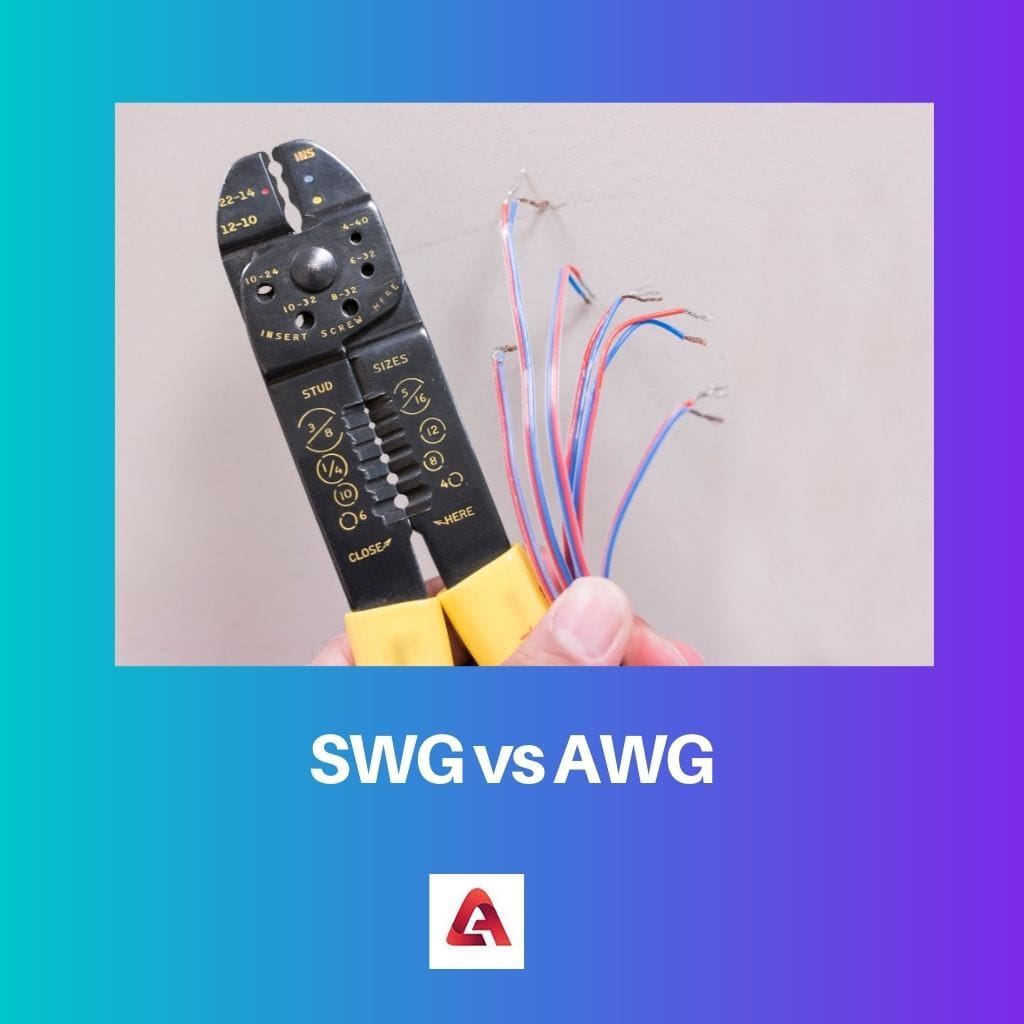AWG was invented in North America. It was popularized as the American wire measurement standard and still holds the nationality of its origin within the abbreviation of its name.
The derivation of each system also influences its popularity in different parts of the world. While SWG is frequently used in Britain, AWG is implemented to measure wires in America and Canada.
Key Takeaways
- SWG stands for Standard Wire Gauge and is a British wire gauge standard used for measuring the diameter of electrical wires, while AWG stands for American Wire Gauge and is an American wire gauge standard used for the same purpose.
- SWG measures the diameter of the wire in terms of the number of draws required to produce a given diameter. In contrast, AWG measures the diameter of the wire in terms of a specific mathematical formula.
- SWG is commonly used in the United Kingdom and India, while AWG is used in the United States.
SWG vs AWG
The difference between SWG and AWG is that the former originated in Britain, while the latter originated in the United States. The Standard Wiring Gauge and the American Wiring Gauge are wire-size measurement systems used in different parts of the world. The most striking difference is that SWG was devised in Great Britain. Initially, it was also known as the British Standard Wire Gauge.

Comparison Table
| Parameters of Comparison | SWG | AWG |
|---|---|---|
| Compatibility | SWG is used for ferrous metals. | AWG is used in conjunction with non-ferrous metals. |
| Full Form | SWG stands for Standard Wire Gauge. | AWG stands for American Wire Gauge. |
| Origination | The SWG is considered to be a British wire measuring system as it originated in Britain. | The AWG originated in North America. |
| Alternative Terms of Reference | British Wire Gauge and the Imperial Wire Gauge are the other terms of reference used for SWG. | Brown & Sharpe is an alternative term of reference for AWG. |
| Length | SWG wires are longer than AWG. | AWG wires are shorter than SWG wires. |
| Steps | SWG has 50 steps. | AWG has 40 steps. |
| Measurement Units Used | The wires are measured in inches. | The metric system is used. |
| Current Popularity | SWG is not a very popular choice. Now, SWG is used to measure guitar wires. | AWG is the more frequently chosen wire gauge system. It is frequently used to measure electric wires. |
What is SWG?
SWG stands for the Standard Wiring Gauge system. This wire gauge standard originated from Britain and is frequently called the British Wire Gauge system or the Imperial Wire Gauge standard.
It has been the sole measuring standard in the UK since 1884. Its derivational history has also effectively circumscribed the usage of the standard to mainly Great Britain and its surrounding areas.
SWG wires are made of ferrous metals. A wire measured using the SWG standard tends to be bigger than the one measured with the AWG system. The thinnest wire diameter of an SWG wire is 0.003 inches.
The usage of the SWG system has declined over the years. Currently, it is mainly used to measure guitar wires. However, industries that use wires for non-electrical purposes also use the SWG system.
What is AWG?
The standard wire measuring system used in America is AWG. The abbreviation stands for the American Wiring Gauge. AWG is also commonly known as the Brown & Sharpe system. Wires measured using this system tend to be smaller than the ones measured by the SWG system.
With 40 steps, AWG offers better current conduction and protection. With SWG gradually fading away, it is widely used in measuring electric wires.
The smallest diameter of an AWG wire is 0.003 inches. This system is used for wires that are made with non-ferrous metals. Wires measured using the AWG system tend to be longer than the ones measured with the SWG system.
Main Differences Between SWG and AWG
- The main difference between SWG and AWG is that SWG is the commonly used wire size measuring standard derived from Britain, while AWG is the equivalent standard derived from North America. The former standard has been extensively used in Britain and its surrounding regions, while AWG has been the standard wire size measuring system in America and Canada.
- The full form of each abbreviation is also different. AWG stands for the American Wire Gauge, while SWG stands for Standard Wire Gauge.
- The SWG system originated in Britain. However, the AWG system originated in North America.
- The two differing wire gauge systems have differing alternative referral terms. AWG is also known as Brown & Sharpe. Alternatively, SWG is known as the British Wire Gauge or the Imperial Wire Gauge.
- Another potent difference between the SWG and AWG measuring systems is that the former is used for a more diverse variety of metals than the latter. The AWG is used for non-ferrous metals, while the SWG is commonly used for ferrous metals.
- SWG wires tend to be bigger than AWG of the same gauge.
- The SWG system measures wires in inches, while the AWG measures them using the metric measurement system.
- The number of steps in each wire gauge system is different. AWG has 40 steps, while SWG has 50 steps.
- The smallest wire diameter for an AWG-measured wire is 0.003 inches, while that of an SWG-measured wire is 0.001 inches.
- The two also differ in terms of their current popularity. The AWG is more frequently used to measure wires. Currently, SWG is infrequently used to measure electrical wires. It is more used to measure guitar wires.